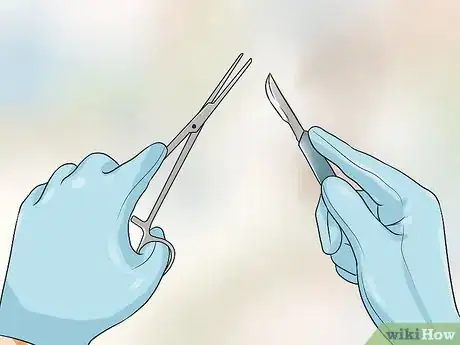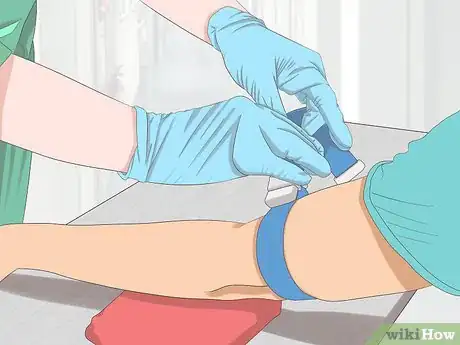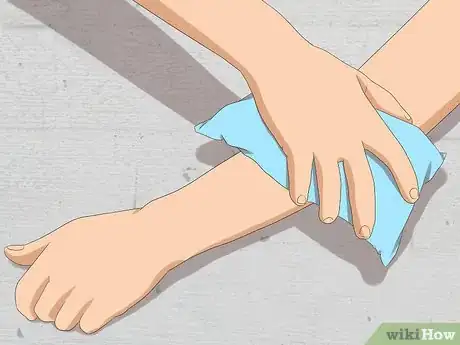This article was medically reviewed by Sarah Gehrke, RN, MS. Sarah Gehrke is a Registered Nurse and Licensed Massage Therapist in Texas. Sarah has over 10 years of experience teaching and practicing phlebotomy and intravenous (IV) therapy using physical, psychological, and emotional support. She received her Massage Therapist License from the Amarillo Massage Therapy Institute in 2008 and a M.S. in Nursing from the University of Phoenix in 2013.
There are 23 references cited in this article, which can be found at the bottom of the page.
wikiHow marks an article as reader-approved once it receives enough positive feedback. In this case, 95% of readers who voted found the article helpful, earning it our reader-approved status.
This article has been viewed 397,879 times.
ESR (erythrocyte sedimentation rate) is a test that can tell you how much sedimentation and inflammation is in your body. It measures how quickly your red blood cells fall to the bottom of a super-thin tube. If you have a moderately elevated ESR, you probably also have painful inflammation that you’d like to reduce. Target this inflammation with diet and exercise. You should also see if there are other medical reasons for an elevated or high ESR rate by consulting with your doctor. You may need to have your ESR tested over time.
Things You Should Know
- Do the most vigorous exercise you’re able and center your diet around fruits, veggies, nuts, and healthy oils. Avoid processed, sugary foods.
- Support your diet and exercise by staying hydrated and taking any prescribed medications from your doctor.
- A high or very high level may be a symptom of another condition. Expect to take multiple blood draw tests over time for a diagnosis.
Steps
Lowering Inflammation and ESR with Diet and Exercise
-
1Perform vigorous exercise regularly if you’re able to. In order to do a vigorous-intensity workout, you’ve got to work pretty hard. Whichever activity you choose should make you sweat, elevate your heart rate, and make you think, “wow, this is tough!” Work out for a minimum of 30 minutes at least 3 times per week.[1] This type of exercise has been shown to significantly reduce inflammation.[2]
- Examples of vigorous activities include going for a run or a fast bike ride, swimming laps, doing aerobic dancing, or hiking uphill.[3]
-
2Use light to moderate exercise as an alternative. If you’ve never really exercised before or have a condition that keeps you from doing vigorous activity, go for a lighter workout that lasts at least 30 minutes. Even moving a little bit each day will help bring down your inflammation.[4] Push yourself until you feel like you’ve reached the point of, “ok, this is hard, but I’m not struggling yet.”[5]
- Go for a walk around the block at a brisk pace or sign up for a water aerobics class.
Advertisement -
3Do 30 minutes of yoga nidra each day. Yoga nidra is a type of yoga practice that involves suspending yourself between wakefulness and sleep. It should help you feel complete mental and physical relaxation. In at least 1 study, doing this activity significantly reduced elevated ESR levels. To do yoga nidra:[6]
- Lie flat on your back on a mat or other comfortable surface.
- Listen to the voice of your yoga instructor (download an app or find an audio recording or video if you can’t find a yoga studio that offers this practice).
- Allow your breath to flow naturally in and out of your body.[7]
- Do not move your body during the practice.
- Allow your mind to float from point to point, staying aware without concentrating.
- Achieve “sleep with a trace of awareness.”
-
4Avoid processed, sugary foods. These foods contain a harmful type of cholesterol (LDL) that can cause inflammation in the body.[8] This inflammation may also raise your ESR level. In particular, avoid french fries and other fried food, white bread, pastries, soda, red and processed meat, and margarine or lard.[9]
-
5Consume fruits, veggies, nuts, and healthy oils. These options all form the basis of a healthy diet, along with lean meats like chicken and fish. There are also some specific inflammation-fighting fruits, veggies, and oils that you should incorporate into your meals several times per week. These include:[10]
- Tomatoes.
- Strawberries, blueberries, cherries, and/or oranges.
- Green leafy vegetables like spinach, kale, and collards.
- Almonds and/or walnuts.
- Fatty fish (with high oil content) like salmon, mackerel, tuna, and sardines.
- Olive oil.
-
6Add herbs like oregano, cayenne, and basil to your cooking. These ingredients naturally fight inflammation in the body, so incorporate them into your meals whenever you can. Luckily, using herbs is a great way to spice up your meal plans (pun intended)! You can also use ginger, turmeric, and white willow bark to reduce inflammation and your ESR level.[11]
- Look up recipes that include the herbs you’d like to cook with online.
- For ginger and willow bark, use a tea infuser to make herbal tea.
- Do not take willow bark if you’re pregnant or breastfeeding.
-
7Drink plenty of fluids each day. While being dehydrated may not worsen your inflammation, hydration is crucial for avoiding muscle and bone damage.[12] Given that you’re ramping up your activity level to bring down inflammation, it’s important to drink water to avoid injury. Shoot for at least 1 to 2 litres (0.26 to 0.53 US gal) each day.[13] Drink some water right away if you’re experiencing any of the following symptoms:[14]
- Extreme thirst
- Fatigue, dizziness, or confusion
- Less frequent urination
- Dark-colored urine
Dealing with Elevated ESR Test Results
-
1Consult with your doctor to understand your test results. Just like most other laboratory tests, the normal ranges might be different depending on which lab your doctor uses. Sit down with your doctor when your results become available so you can talk through them together. In general, expect normal ranges to be:[15]
- Less than 15 mm/hr (millimeters per hour) for men under 50.
- Less than 20 mm/hr for men over 50.
- Less than 20 mm/hr for women under 50.
- Less than 30 mm/hr for women over 50.
- 0-2 mm/hr for newborns.
- 3-13 mm/hr for newborns to puberty.
-
2Ask your doctor if your ESR is elevated or very high. There are a number of conditions that could cause your ESR rate to be above normal, including pregnancy, anemia, thyroid or kidney disease, or cancers such as lymphoma or multiple myeloma. A very high ESR level might indicate lupus, rheumatoid arthritis, or a severe infection located somewhere in your body.[16]
- A very high level might also be a sign of rare autoimmune disorders like allergic vasculitis, giant cell arteritis, hyperfibrinogenemia, macroglobulinemia, necrotizing vasculitis, or polymyalgia rheumatica.
- An infection associated with a very high ESR level might be located in your bones, heart, on your skin, or throughout your body. It could also be tuberculosis or rheumatic fever.
-
3Expect to take other tests to get a diagnosis. Since an elevated or even high ESR rate could mean so many different things, your doctor will almost certainly perform other tests to understand what’s going on in your body. While you wait for your doctor to determine which tests you need, breathe and try not to panic. Discuss your fears with your doctor, family, and friends so you can feel supported through this process.[17]
- An ESR test can’t provide a diagnosis on its own.
-
4Get your ESR tested over time to check your levels. Because an elevated ESR is often associated with chronic pain or inflammation, your doctor may want you to come in for a regular check up. Monitoring your ESR level during these routine visits will allow them to keep an eye on your pain and the inflammation in your body. Hopefully, with the right treatment plan, it’ll be going down!
-
5Aid treatment of rheumatoid arthritis with meds and physical therapy. Unfortunately, rheumatoid arthritis can’t be completely cured. However, it is possible to manage the symptoms and put them into remission. Your doctor will likely prescribe a combination of disease-modifying antirheumatic drugs (DMARDs), nonsteroidal anti-inflammatory drugs (NSAIDs) like ibuprofen, and steroids.[18]
- Physical or occupational therapy can help you learn exercises to keep your joints moving and flexible. They can also teach you alternative methods for doing daily tasks (like pouring yourself a glass of water) in case of extreme pain.
-
6Help control lupus flare-ups with NSAIDs and other meds. Every case of lupus is different, so you’ll need to work closely with your doctor to decide what course of action is best for you. NSAIDs can help manage pain and fever, and corticosteroids can control inflammation. Your doctor may also recommend antimalarials and immunosuppressants, depending on your symptoms.[19]
-
7Address bone and joint infections with antibiotics and/or surgery. Elevated ESR levels can indicate a number of different infections, but they most accurately pinpoint infections located in the bones or joints. These infections are particularly difficult to treat, so your doctor will want to do other tests to determine the type and source of the problem. In serious cases, they may need to do surgery to remove the infected tissue.[20]
-
8Get a referral to an oncologist if you’re diagnosed with cancer. A very high ESR level (above 100 mm/hr) can indicate malignancy, or the presence of cells that can invade nearby tissues and spread cancer.[21] In particular, high ESR may point to multiple myeloma, or cancer in the bone marrow.[22] If you are diagnosed with this condition using other blood tests, as well as scans and a urine test, an oncologist will work closely with you to develop a specialized treatment plan.[23]
Testing Your ESR Level
-
1Visit your doctor if you think you need an ESR test. An ESR test is most commonly used to see if there’s inflammation in your body that’s causing you to be in pain. If you have unexplained fevers, arthritis, muscle pain, or visible inflammation, an ESR test can help your doctor better understand the source and severity of these issues.[24]
- An ESR test might also be useful in diagnosing unexplained symptoms like a poor appetite, unexplained weight loss, headaches, or shoulder and neck pain.[25]
- An ESR test is rarely done on its own. At the very least, your doctor will probably also order a C-reactive protein (CRP) test.[26] This test is also used to check for inflammation in the body.[27]
-
2Discuss any medications you’re on with your doctor. There are several different over-the-counter and prescription drugs that could either elevate or lower your natural ESR level. If you’re on any of these meds, your doctor may ask you to stop taking them up to a week before you take the test. Do not change your medications without consulting your doctor.[28]
- Dextran, methyldopa, oral contraceptives, penicillamine procainamide, theophylline, and vitamin A can increase ESR.
- Aspirin, cortisone, and quinine could lower your ESR level.
-
3Tell the health professional which arm you’d like blood drawn from. Usually, blood will be drawn from the crook of your elbow. While there shouldn’t be much pain or swelling after this test, you may want to ask if blood can be drawn from your non-dominant arm. The health care professional will also want to look for the best veins.[29]
- Choosing a good vein will cause the test to go a bit faster.
- If your health professional can’t find a good vein in either arm, they may look for another spot to draw from.[30]
- You should also tell the person who’s drawing your blood about your past experiences with these types of tests. If you experience faintness or lightheadedness during blood draws, they may lay you down to keep you from getting hurt if you faint. If you don’t do well with blood tests, consider getting a ride to and from the test.
-
4Remain relaxed while your blood is drawn. The health care professional will tie an elastic band around your upper arm and swab the draw site with alcohol. Then they’ll insert a needle into the vein and drain your blood into a tube. Once they’re done, they’ll remove the needle and release the elastic. Finally, the nurse or doctor will give you a small gauze pad and ask you to put pressure on the spot.[31]
- If you’re nervous, don’t look at your arm while your blood is being drawn.
- They may need to fill more than one tube. Don’t be alarmed if this happens.
- They may use a compression bandage to keep the pressure on and stop the bleeding more quickly after you leave the office. You can remove this bandage at home after a few hours have passed.
-
5Expect some bruising or redness. In most cases, the blood draw site will heal in just a day or 2, but it may appear a bit red or even bruised as it’s healing. This is normal.[32] In rare cases, the vein used for the test may become swollen. This isn’t serious, but it might be painful. Ice it the first day, then move on to a warm compress. Make a warm compress by heating up a damp washcloth in the microwave for 30-60 seconds. Apply it to the site in 20-minute sessions a few times per day.
- Test the washcloth’s temperature by hovering your hand over it. If the steam coming off the cloth is too hot for you to hold your hand above it, wait 10-15 seconds before testing the temperature again.
-
6Contact your doctor if you develop a fever. If the pain and swelling at the blood draw site gets worse, you may be developing an infection. This is a very rare reaction. However, if you do develop a fever, contact your doctor right away.
- If you have a fever of 103℉ (39℃) or higher, your doctor may recommend that you go to the emergency room.[33]
References
- ↑ http://www.heart.org/HEARTORG/HealthyLiving/PhysicalActivity/FitnessBasics/Moderate-to-Vigorous---What-is-your-level-of-intensity_UCM_463775_Article.jsp#.WeT4rxNSxok
- ↑ https://www.ncbi.nlm.nih.gov/pubmed/12192226
- ↑ http://www.heart.org/HEARTORG/HealthyLiving/PhysicalActivity/FitnessBasics/Moderate-to-Vigorous---What-is-your-level-of-intensity_UCM_463775_Article.jsp#.WeT4rxNSxok
- ↑ https://www.ncbi.nlm.nih.gov/pubmed/12192226
- ↑ http://www.heart.org/HEARTORG/HealthyLiving/PhysicalActivity/FitnessBasics/Moderate-to-Vigorous---What-is-your-level-of-intensity_UCM_463775_Article.jsp#.WeT4rxNSxok
- ↑ http://nopr.niscair.res.in/bitstream/123456789/13871/1/IJTK%2011%282%29%20358-361.pdf
- ↑ https://www.yogajournal.com/meditation/10-steps-of-yoga-nidra
- ↑ https://www.health.harvard.edu/staying-healthy/the-truth-about-fats-bad-and-good
- ↑ https://www.health.harvard.edu/staying-healthy/foods-that-fight-inflammation
- ↑ https://www.health.harvard.edu/staying-healthy/foods-that-fight-inflammation
- ↑ http://www.newhealthadvisor.com/how-to-reduce-esr-in-blood.html
- ↑ https://www.ncbi.nlm.nih.gov/pmc/articles/PMC4755996/
- ↑ http://www.newhealthadvisor.com/how-to-reduce-esr-in-blood.html
- ↑ https://www.mayoclinic.org/diseases-conditions/dehydration/symptoms-causes/syc-20354086
- ↑ https://medlineplus.gov/ency/article/003638.htm
- ↑ https://medlineplus.gov/ency/article/003638.htm
- ↑ https://medlineplus.gov/ency/article/003638.htm
- ↑ https://www.mayoclinic.org/diseases-conditions/rheumatoid-arthritis/diagnosis-treatment/drc-20353653
- ↑ https://www.mayoclinic.org/diseases-conditions/lupus/basics/treatment/con-20019676
- ↑ https://www.ncbi.nlm.nih.gov/pmc/articles/PMC4091374/
- ↑ https://www.cancer.gov/publications/dictionaries/cancer-terms?cdrid=45771
- ↑ https://www.rcpa.edu.au/Library/Publications/Common-Sense-Pathology/Docs/2014/Making-Sense-of-Inflammatory-Markers
- ↑ https://www.mayoclinic.org/diseases-conditions/multiple-myeloma/diagnosis-treatment/drc-20353383
- ↑ https://medlineplus.gov/ency/article/003638.htm
- ↑ https://labtestsonline.org/understanding/analytes/esr/tab/test/
- ↑ https://www.mayoclinic.org/tests-procedures/sed-rate/details/why-its-done/icc-20207019
- ↑ https://labtestsonline.org/understanding/analytes/crp/tab/glance/
- ↑ https://labtestsonline.org/understanding/analytes/esr/tab/test/
- ↑ http://www.onemedical.com/blog/live-well/blood-draw-faq/
- ↑ http://www.registerednursern.com/how-to-draw-blood-drawing-blood-clinical-nursing-skills-for-rns/
- ↑ http://www.nhs.uk/conditions/Blood-tests/Pages/Introduction.aspx
- ↑ http://www.onemedical.com/blog/live-well/blood-draw-faq/
- ↑ http://www.mayoclinic.org/diseases-conditions/fever/symptoms-causes/dxc-20341502
About This Article
To reduce ESR, which is sedimentation and inflammation in your body, perform vigorous exercise regularly, if you’re able to. Work out for a minimum of 30 minutes at least 3 times a week at a level that makes you sweat and elevates your heart rate, which can significantly reduce inflammation. If you can’t vigorously exercise at this time, then try a lighter workout, which can still bring down your inflammation. In addition to exercise, avoid processed, sugary foods, which can cause inflammation in the body. Instead, focus on eating more fruits, vegetables, and healthy oils, like olive oil and fatty fish. For more tips from our Medical co-author, like how to use herbs to reduce ESR, keep reading!























-Step-16.webp)













-Step-16.webp)




































Medical Disclaimer
The content of this article is not intended to be a substitute for professional medical advice, examination, diagnosis, or treatment. You should always contact your doctor or other qualified healthcare professional before starting, changing, or stopping any kind of health treatment.
Read More...